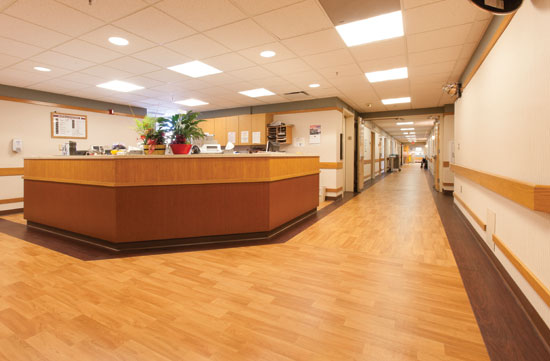New Trends in Resilient Flooring for Healthcare Environments
Learning Objectives:
- Discuss major changes in the healthcare industry with a direct impact on design and product selection, including a strong emphasis on patient well-being, satisfaction, and outcome.
- Analyze unique performance requirements of flooring in healthcare environments and their close relationship to the safety and comfort of patients and staff.
- Evaluate different types of resilient flooring for specific healthcare applications, including new technologies that are changing familiar products to improve performance, sustainability, and patient experience.
- Select flooring that contributes to effective, evidence-based environments for healing.
Credits:
Afew years ago, a boom in capital construction was predicted to provide an aging population with additional beds. Now, although large new hospitals are still being built, by far the greatest growth is in renovation, modernization, and the construction of new, specialized spaces, such as outpatient clinics and units focusing on specific needs.
Two of the major trends affecting the design of these new spaces sometimes seem to be in direct conflict. A large body of knowledge now exists documenting how the physical environment of a healthcare facility directly affects patient outcomes. Evidence-based design can promote healing, safety, and a positive experience for patients, families, and staff. At the same time, cost constraints are more severe. It seems the more healthcare design, products, and materials can do, the less money there is to pay for them.
But the changing structure of the healthcare industry is also rewarding the use of evidence-based design in many important ways. Healthcare is shifting from a fee-for-services model to a fee-for-performance model. Under the Affordable Care Act (ACA), costs associated with avoidable incidents, such as hospital-acquired infections (HAIs) and slip/fall injuries, are not reimbursable and are borne by the healthcare provider. Medicare payments are linked to factors, such as scores on patient satisfaction surveys, length of hospital stays, and the number of readmissions. Many private insurers are following suit. Reimbursement at risk has created a healthcare dynamic where the emphasis on efficiency must be paired with quality and patient satisfaction.
Part of the answer is more choice in products that can contribute to good outcomes while controlling costs. The selection of flooring will directly affect major components of safety and satisfaction for both patients and staff, including acoustics, protection from injury, prevention of HAIs, and creating a safe, positive healing environment. The same choices will result in cost saving and efficiency through better patient experiences, improved staff efficiency and retention, reduced liability for infection and injury, and reduced costs for maintenance and energy.

Photo courtesy of Ecore Commercial Flooring
Nurses station and hallway at the Vernon Memorial Healthcare (VMH) medical building in Viroqua, Wisconsin. No-wax sheet vinyl flooring with the appearance of wood planks was chosen for performance characteristics as well as a warm, natural look.









